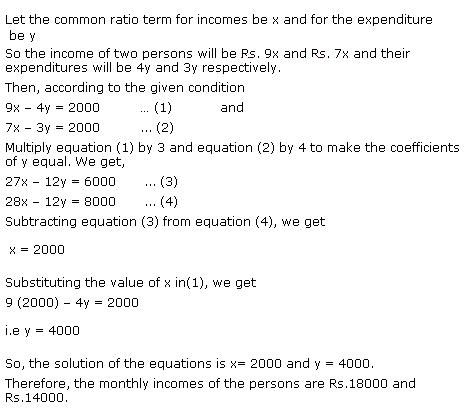Ask questions which are clear, concise and easy to understand.
Ask QuestionPosted by Bushral Thara 5 years, 5 months ago
- 5 answers
Posted by Тђє Ғїԍђтєя 5 years, 5 months ago
- 5 answers
Posted by Pramod Kumar Pandey 5 years, 5 months ago
- 1 answers
Jaya Mishra 5 years, 5 months ago
Posted by Navin Tg 10 D Srv 5 years, 5 months ago
- 1 answers
Gaurav Seth 5 years, 5 months ago
Let their salaries be 9x and 7x
let their expenditure be 4y and 3y
so,
9x-4y=2000—(1)
7x-3y=2000—(2)
so,
from (1)
x=(2000+4y)/9—(3)
put x in (2)
7[(200+4y)/9]-3y=200
(1400+28y)/9-3y=200
(1400+28y-27y)/9=200
y+1400=1800
y=400
now put y in (3)
x=(2000+4×400)/9
x=(2000+1600)/9
x=18000/9
x=2000
so,
salary of first person=9×2000=18000 rs
salary of second person=7×2000=14000 rs
OR
Posted by Abhiraj Pandit 5 years, 5 months ago
- 1 answers
Gaurav Seth 5 years, 5 months ago
We know that a quadratic polynomial when the sum and product of its zeroes are given by
p(x) = K {x2 – (sum of the zeroes) x + Product of zeroes},
where K is a constant.
Therefore, required quadratic polynomial p(x) is given by
p(x) K[x2–(-3x)+(1)] = K (x2 +3x +2).
Posted by Aryan Kothari 5 years, 5 months ago
- 0 answers
Posted by Manan Vijay 5 years, 5 months ago
- 0 answers
Posted by Sonali Pathak 5 years, 4 months ago
- 1 answers
Posted by Pratyush Mishra 5 years, 5 months ago
- 1 answers
Aryan Kothari 5 years, 5 months ago
Posted by Praveen Kumar Mahto 5 years, 5 months ago
- 1 answers
Sia ? 4 years, 7 months ago
Let y axis divide the line segment joining the point (-2,-3) and (3,7) in m:n. The coordinates of the point of division is (0,y). The coordinates of the point of division is (0,y). The required ratio is 2:3.
Posted by Anshu Choudhary 5 years, 5 months ago
- 2 answers
Posted by Pramila Devi 5 years, 5 months ago
- 1 answers
Gaurav Seth 5 years, 5 months ago
10th term in given A.P = 28
Step-by-step explanation:
Given A.P : 1,4,7,10, ...
First term (a) = 1,
n = 10,
Therefore,
10th term in given A.P = 28
Posted by Loveena Tovino 5 years, 5 months ago
- 1 answers
Yogita Ingle 5 years, 5 months ago
Let quadratic polynomial be 
Let α and β are two zeroes of above quadratic polynomial.
α+β =  =
= 
α × β = -1 
 =
= 


 Quadratic polynomial which satisfies above conditions =
Quadratic polynomial which satisfies above conditions = 
Posted by Adya Kumari 5 years, 5 months ago
- 1 answers
Posted by Sai Yadav 5 years, 5 months ago
- 0 answers
Posted by Harwinder Singh 5 years, 5 months ago
- 0 answers
Posted by Yashita Jaswal 5 years, 5 months ago
- 1 answers
Posted by Lakshay Saini 5 years, 5 months ago
- 1 answers
Meghna Thapar 5 years, 5 months ago
This theorem states that an angle bisector divides the opposite side of a triangle into two segments that are proportional to the triangle's other two sides. In the triangle below, that's AB/BD = AC/CD. We then used the theorem to find the missing length in a triangle with an angle bisector. An angle bisector is a line or ray that divides an angle into two congruent angles . ... Some textbooks call this Angle Bisector Theorem , but this name is usually used for another theorem about angle bisectors in a triangle. Example : In the figure, →BD is an angle bisector.
Posted by Naman Kaur 5 years, 5 months ago
- 2 answers
? Pranali.A.P ? 5 years, 5 months ago
Posted by Vaishnavi Saha 5 years, 5 months ago
- 2 answers
Vaishnavi Saha 5 years, 5 months ago
Gaurav Seth 5 years, 5 months ago
Question : If the zeros of the polynomial ax²+bx+b=0 are in the ratio m:n then find the value of √(m/n)+√(n/m) .
Answer :

OR
let the zeros of the given polynomial ax^2+bx+c be m"alpha" and n"alpha"
m "alpha " + n"alpha" = -b/a
=>"alpha"= -b/a(m+n)------------------(i)
and similarly product of zeros
=> mn"alpha^2"=b/a-------------(ii)
Now,
Putting the value of equation (i) in equation (ii)
You would get the desired answer which is
root m/ root n +root n/root m
=>root b/a
Posted by Navdeep Gill 5 years, 5 months ago
- 2 answers
Yogita Ingle 5 years, 5 months ago
3x+Ky=15
3(1) + k (2) =15
3 + 2k = 15
2k = 15 - 3
2k = 12
k = 12/2
k = 6
Posted by Altaf Ahmad Sofi 5 years, 5 months ago
- 2 answers
Posted by Rajendra Goud 5 years, 5 months ago
- 0 answers
Posted by Deepali Bansiwal 5 years, 5 months ago
- 1 answers
Yogita Ingle 5 years, 5 months ago
Let the original speed of train be  km/h.
km/h.
then increased speed  km/hr
km/hr
usual time  hours
hours
New time hours
hours
According to the question



Rejecting the negative value, we have x = 45
Hence usual speed of train = 45 km/hr.
Posted by Ambreen Kaur Deol 5 years, 5 months ago
- 0 answers
Posted by Sporty⚾⚽? Boy ??? 5 years, 5 months ago
- 4 answers
Posted by Shivansh Prajapati 5 years, 5 months ago
- 2 answers

myCBSEguide
Trusted by 1 Crore+ Students

Test Generator
Create papers online. It's FREE.

CUET Mock Tests
75,000+ questions to practice only on myCBSEguide app
 myCBSEguide
myCBSEguide

Bushral Thara 5 years, 5 months ago
0Thank You